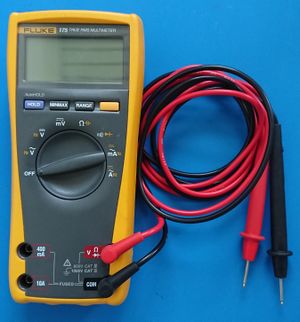Multimeters
From CoMakingSpace Wiki
| ToolInfoBox Multimeters | |
|---|---|

| |
| Synonyms: | multitesters; DE: Vielfachmessgeräte |
| Type: | measuring tool |
| Material: | circuits, electronic components |
| Location: | electronics room |
| Access Requirements: | read this page |
| Tutors: | Patrick |
Multimeters are an essential tool for working with electronics. They are used – as the name suggests – to measure various values of a circuit like:
- voltage – unit Volt (V)
- current – unit Ampere (A)
- resistance – unit Ohm (Ω)
- frequency – unit Hertz (Hz)
- capacitance - unit Farad (F)
- diode test – voltage needed to overcome the PN-gap
It is important to be aware of how to measure a certain value properly without interfering or even damaging the multimeter or the circuit. All multimeters have different inputs for measuring current and voltage. The voltage input is protected with a high input impedance (> 1 MΩ). When measuring current, the leads act as a dead short so be very careful when using this mode and always plug the leads back into the voltage input so another person can't accidentally short a circuit when using the multimeter.
How to Measure
- think about what value you want to measure (voltage, current, resistance, …)
- check if the leads are connected to the right input (black to COM and red to relevant input)
- turn the dial to the correct mode
- select the right range (e.g. mV, V) - newer multimeters may have an autorange feature so they select the right range on their own as long as the correct input socket is used
- hold the leads to the two points you want to measure
- done!